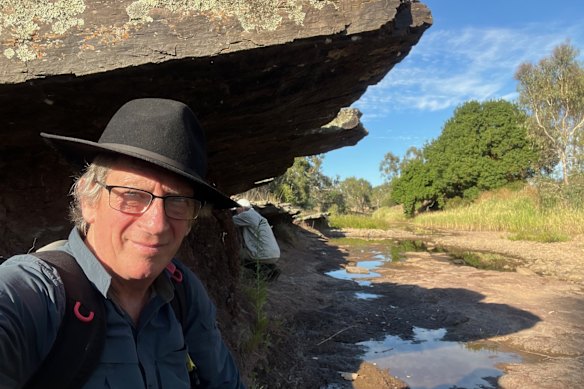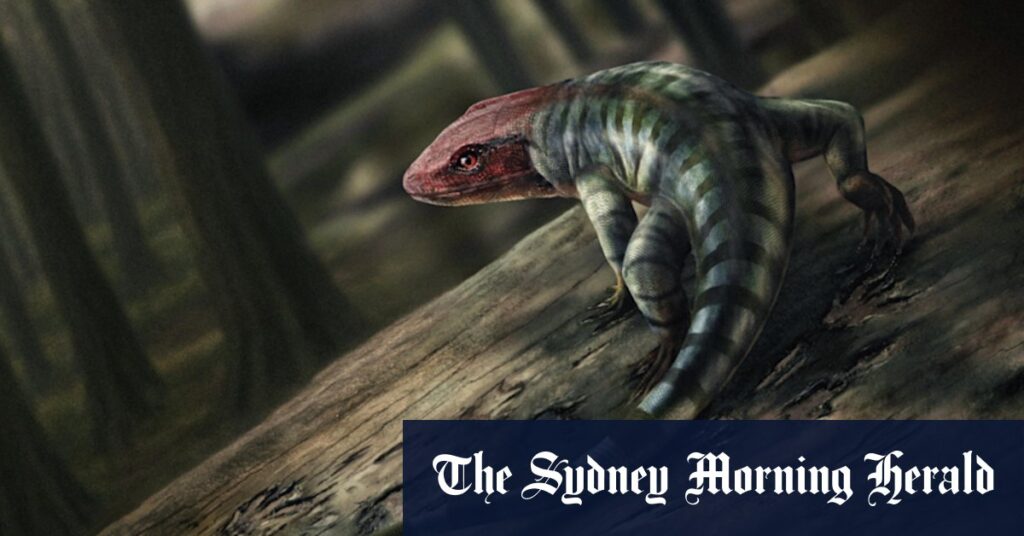“This is really the beginning of life on land as we know it,” says Dr Blake Dickson, a specialist in early tetrapod evolution at the University of NSW.
The fossil compared with a modern iguana foot.Credit: Traci Klarenbeek / Supplied
The headwaters of Broken River rise in the Victorian Alps, before the river twists and turns down towards Shepparton. Its flow is irregular; after heavy winter rainfall it can be the fastest-flowing river in the country, but in summer it often dries to a series of muddy lagoons, exposing its mudstone riverbed.
When life was emerging from the oceans, much of the region the river now charts was covered by vast primordial lakes and muddy swamps.
The footprints were likely captured as the creature strolled along a muddy riverbank. Later, after the mud had hardened, they would have been covered by layers of silt deposited as the river rose, before sinking deeper and deeper into the earth – the start of a 350 million-year journey that eventually led to John Eason and Craig Ury.

Professor John Long in the Mansfield fossil area.Credit: John Long / Supplied
Eason is 74 but retains “a kid’s enthusiasm for dinosaurs”. Twice a year he, Ury and a group of local enthusiasts go hunting for fossils around Mansfield. In early 2021, Ury’s eyes alighted on a chunk of rock, apparently sheared off a formation upriver and now sitting loose by the water. “If you look at it face-on, it’s hard to see,” says Eason, who had initially walked straight past it. “But if you look at it sideways-on, it becomes quite clear – it’s quite dramatic. It was luck, really.”
Eason snapped a photo and sent it to Long, a long-time collaborator he first met at a lecture on fossils at the local library.
The researchers and volunteers searched for fossils along Broken River.Credit: John Long
“I was just absolutely gobsmacked,” recalls Long. “I opened the images and there was this slab just covered in trackways.
“We knew we were onto something big. But we did not know how big.”
Amphibians were the first vertebrate species to succeed on land. They evolved from fish living in shallow water, which themselves had swapped the soft fins of ocean fish for firmer ones that could be pressed into the riverbank.
“In the water you’re basically competing with all the other fish and sharks for the limited food sources that are there,” says Dr Lachlan Hart, a paleontologist at the University of NSW. “The land was basically untapped.”
An artist’s impression of what the amniote may have looked like.Credit: Martin Ambrozik
As they moved onto land, these creatures evolved to have eyes at the front of their head and mobile necks to spot prey. Their vertebrae locked together, providing a strong backbone to support four-legged walking.
But these primitive creatures were not real land-dwellers – they still needed to return to the water to reproduce. It was not until the rise of amniotes – named because they lay eggs, recreating the ocean inside a shell – that vertebrates could truly claim to have colonised land.
The creature that left the footprints was among the first of these amniotes, a group that would diversify and evolve to include mammals and, eventually, humans.
A graphic from the Nature paper, showing the footprint tracks in blue and yellow.Credit: Nature
Professor Long’s team dated the footprints to about 350 million years ago – about 35 million years earlier than scientists had previously believed amniotes evolved. The find suggests amniotes may even have originated in Australia, when it was part of the giant supercontinent Gondwana.
Life was supposed to just be exploring the land, but here was a creature confidently strolling across it.
“You have a relatively advanced type of quadrapedal, terrestrial locomotion. And it’s way earlier than we would expect,” says Dickson. The discovery also pushes tetrapod evolution back by another 30 million years into the past.
“It means tetrapods evolved much quicker than we previously estimated,” says Hart.
We were once all fish, but in these footprints you can see creatures hungry to get onto land and start colonising it.
Enjoyed Examine, our free weekly newsletter covering science with a sceptical, evidence-based eye? Sign up to get the whole newsletter in your inbox.
Read the full article here

